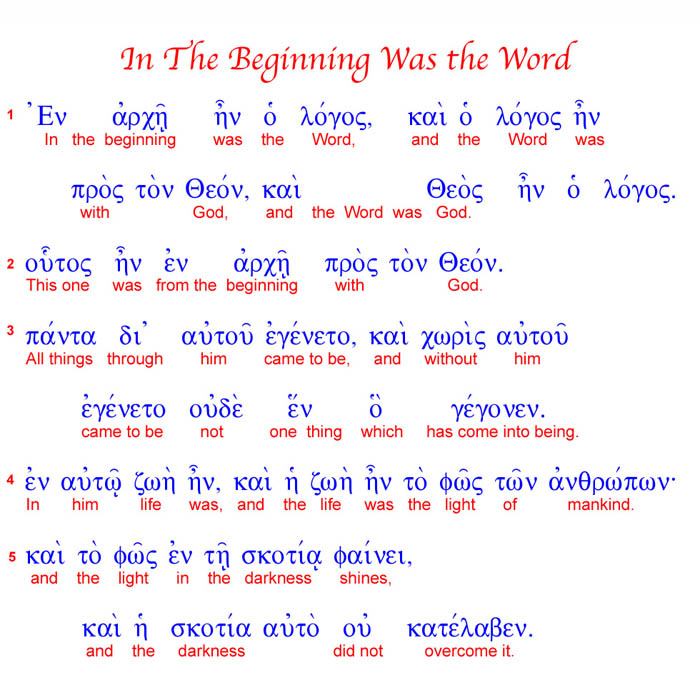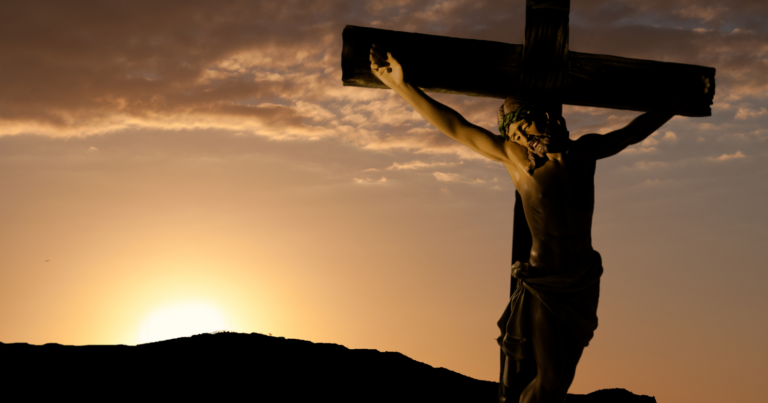“In the beginning was the Word, and the Word was with God, and the Word was God.”
John 1:1
The Prologue to the Gospel of St. John stands as a timeless beacon, illuminating the divine mysteries through the profound symbolism of the Word made flesh.
Within its verses, we can find the essence of our faith from the dawn of creation to the heart of God’s presence among us.
It’s a beautiful yet complex introduction to John’s gospel that requires a deep dive for better understanding
In this article, we aim to unveil the mysteries shrouding this significant scripture passage. We will delve into its symbolism and interpret the theological concepts it presents, helping you see how they apply to your everyday life.
Understanding the Prologue
The Prologue to the Gospel of St. John is a profound passage within the New Testament.
First of all, it sets the stage for the rest of the gospel and introduces us to the concept of “the Word” (Logos), which is revealed to be Jesus Christ.
This mysterious and powerful passage delves into the divine nature of Christ, affirming his existence since the beginning of time with God.
Moreover, it highlights John the Baptizer’s role in testifying about Jesus. This lays a strong foundation for John’s narrative on Jesus’ life, teachings, and resurrection.
Generally, the passage uses beautiful, poetic language to express profound theological concepts, making it both intriguing and challenging to comprehend.
John’s opening lines draw a parallel with the start of the Bible, reminding us that Jesus has always been part of God’s plan.
It’s not merely an introduction, but a compact summary of John’s theology.
5 key themes of the Prologue
1) The ‘Word’ and creation
A central theme of the Prologue is the idea of “the Word” (Logos) as a divine principle active in the creation of the universe.
It emphasizes that everything was made through the Word, denoting Jesus’ divine nature.
This concept positions Jesus not just as a messenger, but as an integral part of God’s creative power.
In simple terms, ‘Logos’ tells us that Jesus was there from the start, not just playing a role in creation but being the force behind it.
When John says, “In the beginning was the Word, and the Word was with God, and the Word was God,” it’s like saying everything that was made, was made through Jesus.
He’s the bridge between God and the universe, the reason behind everything that exists.
This idea sets the stage for understanding Jesus’ role in the world. He’s not just a teacher or healer — He’s the living, breathing expression of God’s creative power, bringing life and light into the world.
2) “The light shines in the darkness”
This theme is all about hope.
John uses the imagery of light and darkness to show the eternal battle between good (light) and evil (darkness).
“The light shines in the darkness, and the darkness has not overcome it.” (John 1:5).
This quote signifies Jesus’ triumph over evil and sin. It suggests that despite the darkness in the world, Jesus’ light is invincible and offers hope and salvation.
And indeed — despite the darkness we see in the world, Jesus’ light is unstoppable.
It’s a reminder that no matter how tough things get, the light of Jesus is always there, cutting through the darkness, offering guidance, and bringing hope.
This light isn’t just a beacon — it’s a force that darkness can never put out, symbolizing Jesus’ enduring presence and the eternal triumph of good over evil.
3) “The Word became flesh”
Now, think about this for a moment: the divine becomes human.
This theme isn’t just a statement — it’s a revolution.
“The Word became flesh” turns our expectations upside down. The infinite, all-powerful God chose to become vulnerable, to live among us, to share in our struggles and joys.
Why?
To bridge the gap between humanity and the divine, to make the incomprehensible God known and accessible to us.
Simply put, it’s a theme that challenges us to see God not as a distant ruler, but as someone who deeply understands what it means to be human.
This incarnation of Jesus is the ultimate act of empathy and love, showing us that no part of our human experience is alien to God.
4) Jesus as a Light
The Prologue challenges us with a critical question: who recognizes Jesus as “the Light”?
It suggests that although Jesus came into the world he created, many failed to recognize or accept him.
Not surprisingly, this question prompts us to examine our own recognition and acceptance of Jesus in our lives.
Let’s be honest: light reveals, guides, and nurtures life.
Similarly, Jesus illuminates our path, showing us the way back to God. He exposes the truth, cutting through the lies and confusion that so often cloud our judgment.
But here’s the thing: this Light is for everyone.
It’s not exclusive — it’s universal, inviting all of us to bask in its warmth and clarity.
This theme asks us to consider: in what ways have we allowed Jesus’ light to penetrate our lives? Are there areas still hidden in shadow, waiting for His revealing glow?
Remember, where this Light shines, darkness cannot prevail.
5) Children of God
“But to all who did receive Him, who believed in His name, He gave the right to become children of God.”
John 1:12-13
Now I want you to pause and let that sink in.
This quote doesn’t express where you’re from or what you’ve done — it’s about welcoming the Light into your life.
By believing in Jesus, an extraordinary transformation happens: we’re adopted into God’s family. It’s a radical idea that shifts identities and destinies.
Being a child of God means you’re no longer defined by your past mistakes or your social status. Instead, you’re identified by your relationship with Jesus, the Light.
This theme prompts us to reflect: do we live like we’re truly part of this divine family?
After all, embracing this identity reshapes how we view ourselves and others, rooted in love and belonging.
6) Role of John the Baptizer
John the Baptist stands out as a pivotal figure in the Prologue, but not in the way you might expect.
His role?
A witness to the Light.
He’s not the star of the show but the one pointing to the star. “He himself was not the light; he came only as a witness to the light.”
John’s whole purpose was to prepare people, to get them ready to recognize and accept Jesus when He arrived.
Think about it: how often do we overlook those who guide us, those who help us see the truth more clearly?
John’s example challenges us to consider how we, too, can be witnesses to Jesus’ light in our world.
Are we pointing others to Jesus, helping illuminate His truth and grace in their lives?
John’s role underscores the power and importance of testimony, reminding us that our lives can significantly impact others’ journeys toward the Light.
Symbolism in the Gospel of John
The Gospel of John is rich with symbols that convey deeper spiritual truths, weaving a narrative that transcends the literal to reveal the divine mysteries of Jesus’ life and mission.
Among these, three symbols stand out for their recurring significance and profound meanings:
- Light: Symbolizing purity, truth, and life, light is a central theme in John’s Gospel. It represents Jesus as the source of spiritual enlightenment and salvation, contrasting the darkness of sin and ignorance.
- Water: Often representing cleansing, renewal, and the sustenance of life, water in John’s Gospel underscores the idea of spiritual rebirth and salvation.
- Bread: Bread signifies sustenance, but in John’s Gospel, it takes on a deeper, spiritual significance, symbolizing Jesus as the “bread of life” (John 6:35). This symbol points to Jesus as the essential nourishment for the soul.
These symbols invite readers to delve deeper into their faith, reflecting on Jesus’ role as the bringer of light, the source of living water, and the bread of life.
They encapsulate key aspects of Christian belief and encourage a more profound, personal exploration of Jesus’ teachings and their implications for believers’ lives.
An interlinear translation of the Prologue of John
Now let’s dive into an interlinear translation of the Prologue of John, covering verses one through eighteen, to explore the original language’s depth and how it shapes our understanding of this foundational Christian text.
This translation adheres closely to the Greek, where word order and grammatical emphasis reveal nuances often overlooked in more fluid English translations.
In the Greek text, verbs like γίνομαι, meaning “I become, am, originate, happen, take place,” play a crucial role in conveying the dynamic nature of the Word’s interaction with creation and humanity.
This verb is a deponent, indicating that while it appears in middle or passive form, it acts with an active meaning, a linguistic feature that enriches the text’s theological depth.
For instance, in verse three, two different tenses of γίνομαι are used: ἐγένετο (second aorist) and γέγονεν (perfect tense).
The aorist tense, ἐγένετο, signifies a specific action in the past, emphasizing the moment of creation.
In contrast, the perfect tense, γέγονεν, indicates a completed action with ongoing effects, highlighting the enduring presence and influence of the Word in the world.
The significance of the Incarnation
“And the Word was made flesh, and dwelt among us, (and we beheld his glory, the glory as of the only begotten of the Father,) full of grace and truth.”
John 1:14
In the prologue, John delivers the profound truth of God becoming man. This is known as the Incarnation, a cornerstone of the Christian faith.
Through Incarnation, God reaches out to humanity in an intimate, personal way. It signifies His immense love and desire for reconciliation with His creation.
The incarnation of Jesus embodies God’s grace and truth. He lived among us, sharing our joys, sorrows, struggles, and victories.
In doing so, He revealed God’s nature and His plan for our salvation.
This profound revelation encourages us to embrace Jesus’ teachings and follow His example in our daily lives. It invites us to experience God’s grace and truth in a deeply personal way.
Applying the Prologue’s wisdom
All in all, the Prologue to the Gospel of St. John is not just a theological exposition. It’s a roadmap for personal spiritual growth.
Its insights on Jesus as ‘The Word’, His divine nature, and His role as ‘the true light’ can guide our faith and actions.
Here’s how its timeless wisdom can be reflected in our daily actions:
- Let the teachings of Jesus guide you through life’s uncertainties, just as the Word brought clarity and light into the world.
- Act as a beacon of hope and kindness, embodying the light of Christ in a world often clouded by darkness.
- Embrace your identity as a child of God, allowing this profound truth to shape your interactions and sense of self-worth.
Incorporating these principles into our daily lives invites the transformative power of the Word into every moment, enlightening our paths and enriching our journey with divine purpose.










